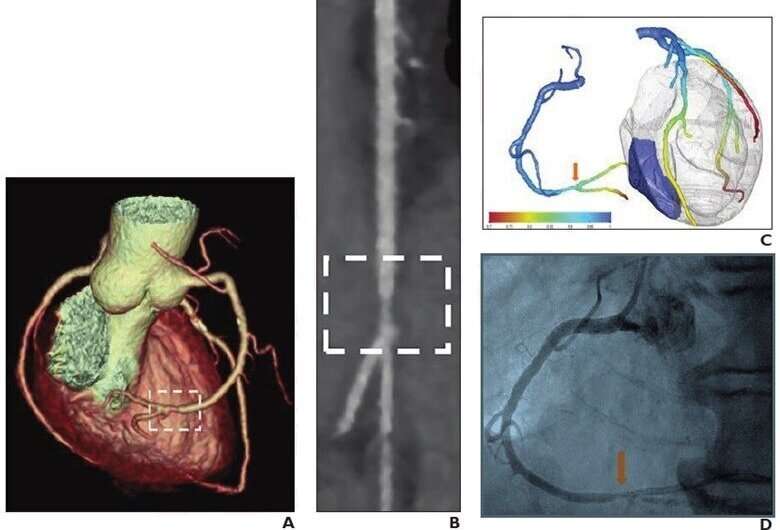This article has been reviewed according to Science X's editorial process and policies. Editors have highlighted the following attributes while ensuring the content's credibility:
fact-checked
peer-reviewed publication
trusted source
proofread
Rapid onsite FFR-CT algorithm helps facilitate clinical adoption

According to a study published in American Journal of Roentgenology (AJR), a high-speed onsite deep-learning based fractional flow reserve (FFR)-CT algorithm yielded excellent diagnostic performance for the presence of hemodynamically significant stenosis, with both high interobserver and intraobserver reproducibility.
"A rapid and accurate onsite approach for determining FFR-CT should address challenges encountered in the clinical adoption of prior FFR-CT implementations," wrote corresponding author Ronny Ralf Buechel, MD, from University Hospital Zurich in Switzerland.
In this AJR study, 59 patients (46 men, 13 women; mean age 66.5 years) underwent coronary CTA (including calcium scoring) followed within 90 days by invasive angiography with invasive FFR and/or instantaneous wave-free ratio (iwFR) measurements from December 2014 to October 2021. Coronary artery lesions were considered to show hemodynamically significant stenosis in the presence of invasive FFR ≤0.80 and/or iwFR ≤0.89.
A single cardiologist evaluated CTA images using an onsite deep-learning based semiautomated algorithm employing a 3D computational flow dynamics model to determine FFR-CT for coronary artery lesions detected by invasive angiography. Then, time for FFR-CT analysis was recorded. FFR-CT analysis was repeated by the same cardiologist in 26 randomly selected examinations, as well as by a different cardiologist in 45 randomly selected examinations.
Ultimately, Buechel and colleagues' onsite deep-learning based FFR-CT algorithm evidenced AUC for hemodynamically significant stenosis—based on invasive angiography—of 0.975, sensitivity of 93.5%, and specificity of 97.7%. Among severely calcified lesions, their same algorithm had AUC of 0.991, sensitivity of 94.7%, and specificity of 95.0%. Moreover, the mean analysis time was 7 minutes and 54 seconds.
"To our knowledge," the authors of this AJR accepted manuscript added, "the currently reported mean processing timer represents the fastest reported time for onsite FFR-CT analysis."
More information: Andreas A. Giannopoulos et al, High-Speed Onsite Deep-Learning Based FFR-CT Algorithm: Evaluation Using Invasive Angiography as Reference Standard, American Journal of Roentgenology (2023). DOI: 10.2214/AJR.23.29156
Nobuo Tomizawa, Editorial Comment: On-Site Deep Learning–Based FFR-CT—A Novel Method to Evaluate Functionally Significant Stenosis, American Journal of Roentgenology (2023). DOI: 10.2214/AJR.23.29561



















